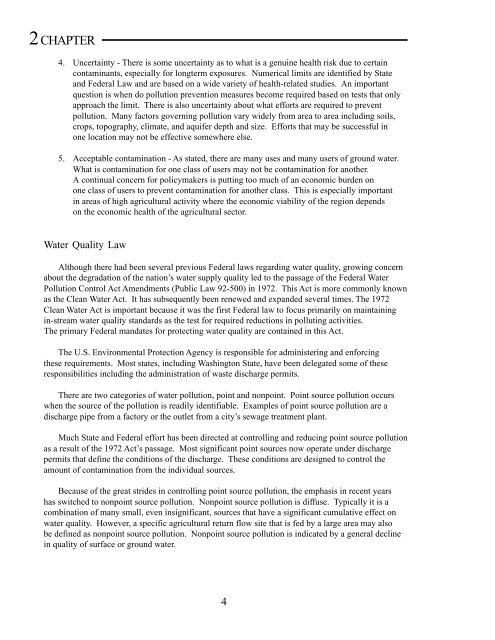Em4885 irrigation management practices to protect ground water
Em4885 irrigation management practices to protect ground water
Em4885 irrigation management practices to protect ground water
Create successful ePaper yourself
Turn your PDF publications into a flip-book with our unique Google optimized e-Paper software.
2 CHAPTER<br />
4. Uncertainty - There is some uncertainty as <strong>to</strong> what is a genuine health risk due <strong>to</strong> certain<br />
contaminants, especially for longterm exposures. Numerical limits are identified by State<br />
and Federal Law and are based on a wide variety of health-related studies. An important<br />
question is when do pollution prevention measures become required based on tests that only<br />
approach the limit. There is also uncertainty about what efforts are required <strong>to</strong> prevent<br />
pollution. Many fac<strong>to</strong>rs governing pollution vary widely from area <strong>to</strong> area including soils,<br />
crops, <strong>to</strong>pography, climate, and aquifer depth and size. Efforts that may be successful in<br />
one location may not be effective somewhere else.<br />
5. Acceptable contamination - As stated, there are many uses and many users of <strong>ground</strong> <strong>water</strong>.<br />
What is contamination for one class of users may not be contamination for another.<br />
A continual concern for policymakers is putting <strong>to</strong>o much of an economic burden on<br />
one class of users <strong>to</strong> prevent contamination for another class. This is especially important<br />
in areas of high agricultural activity where the economic viability of the region depends<br />
on the economic health of the agricultural sec<strong>to</strong>r.<br />
Water Quality Law<br />
Although there had been several previous Federal laws regarding <strong>water</strong> quality, growing concern<br />
about the degradation of the nation’s <strong>water</strong> supply quality led <strong>to</strong> the passage of the Federal Water<br />
Pollution Control Act Amendments (Public Law 92-500) in 1972. This Act is more commonly known<br />
as the Clean Water Act. It has subsequently been renewed and expanded several times. The 1972<br />
Clean Water Act is important because it was the first Federal law <strong>to</strong> focus primarily on maintaining<br />
in-stream <strong>water</strong> quality standards as the test for required reductions in polluting activities.<br />
The primary Federal mandates for <strong>protect</strong>ing <strong>water</strong> quality are contained in this Act.<br />
The U.S. Environmental Protection Agency is responsible for administering and enforcing<br />
these requirements. Most states, including Washing<strong>to</strong>n State, have been delegated some of these<br />
responsibilities including the administration of waste discharge permits.<br />
There are two categories of <strong>water</strong> pollution, point and nonpoint. Point source pollution occurs<br />
when the source of the pollution is readily identifiable. Examples of point source pollution are a<br />
discharge pipe from a fac<strong>to</strong>ry or the outlet from a city’s sewage treatment plant.<br />
Much State and Federal effort has been directed at controlling and reducing point source pollution<br />
as a result of the 1972 Act’s passage. Most significant point sources now operate under discharge<br />
permits that define the conditions of the discharge. These conditions are designed <strong>to</strong> control the<br />
amount of contamination from the individual sources.<br />
Because of the great strides in controlling point source pollution, the emphasis in recent years<br />
has switched <strong>to</strong> nonpoint source pollution. Nonpoint source pollution is diffuse. Typically it is a<br />
combination of many small, even insignificant, sources that have a significant cumulative effect on<br />
<strong>water</strong> quality. However, a specific agricultural return flow site that is fed by a large area may also<br />
be defined as nonpoint source pollution. Nonpoint source pollution is indicated by a general decline<br />
in quality of surface or <strong>ground</strong> <strong>water</strong>.<br />
4
















